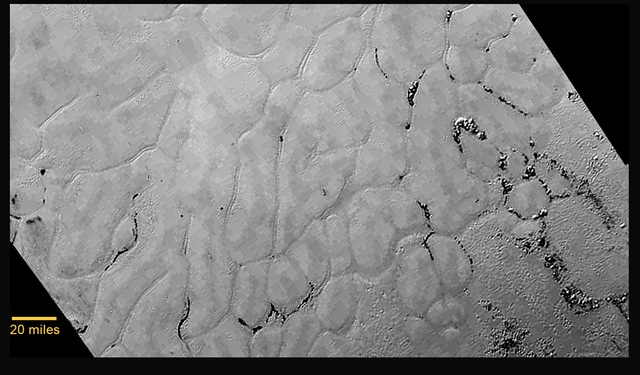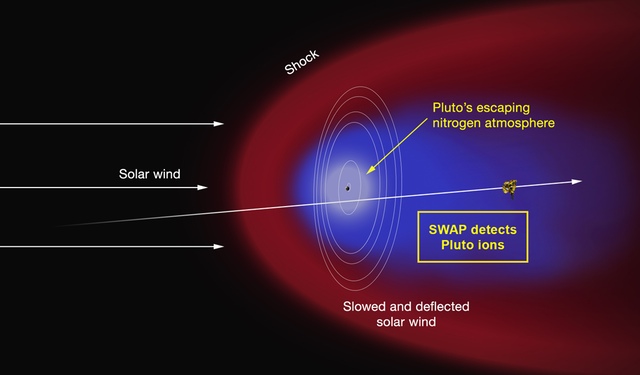Image: NASA/JHUAPL/SWRI
The first detailed images of Pluto, taken by NASA's New Horizons probe, have been arriving back at Earth all week, much to the delight of space enthusiasts around the world. After decades of being shrouded in mystery and conjecture, the Plutonian system has now finally snapped into focus, revealing itself to be well worth the nine year trip."We've only scratched the surface of our Pluto exploration," said New Horizons principal investigator Alan Stern in a NASA statement. "[B]ut it already seems clear to me that in the initial reconnaissance of the solar system, the best was saved for last."Indeed, though the probe's July 14 flyby was brief, the data it collected has revolutionized our understanding of this beloved demoted planet. The first high resolution images were released on Wednesday, and included close-ups of Charon's giant canyons and Pluto's icy mountain ranges.The latest batch of pictures, released on Friday, included this tantalizing shot of Pluto's icy plains. This vast stretch of frozen flatland has been informally named Sputnik Planum (or the Sputnik plains). It is located in the center of the heart-shaped region of the planet known as Tombaugh Regio after Clyde Tombaugh, who discovered Pluto in 1930.New Horizons imaged these planes from a distance of about 48,000 miles; close enough to clearly observe that the region is eerily bereft of craters. This fresh-faced appearance suggests that Sputnik Planum isno older than 100 million years, and that it has been shaped by recent—and potentially, current—geological activity.At this point, the mission leads aren't sure whether the idiosyncratic cracks in these newly discovered plains are formed when Pluto's surface contracts, or whether there is some kind of interior convection process behind their formation."This terrain is not easy to explain," said New Horizons geophysics lead Jeff Moore, in a statement. "The discovery of vast, craterless, very young plains on Pluto exceeds all pre-flyby expectations."To that point, the post-flyby world is shaping up to be every bit as exciting as the lead-up to the July 14 encounter, as New Horizons continues to process and transmit information about its Plutonian encounter back to Earth.In addition to the new pictures of Sputnik Planum, for example, the mission leads discovered that Pluto's nitrogen-rich atmosphere is being stripped away by the solar wind, generating a 68,000-mile-long plasma tail "downstream" of the planet.
This vast stretch of frozen flatland has been informally named Sputnik Planum (or the Sputnik plains). It is located in the center of the heart-shaped region of the planet known as Tombaugh Regio after Clyde Tombaugh, who discovered Pluto in 1930.New Horizons imaged these planes from a distance of about 48,000 miles; close enough to clearly observe that the region is eerily bereft of craters. This fresh-faced appearance suggests that Sputnik Planum isno older than 100 million years, and that it has been shaped by recent—and potentially, current—geological activity.At this point, the mission leads aren't sure whether the idiosyncratic cracks in these newly discovered plains are formed when Pluto's surface contracts, or whether there is some kind of interior convection process behind their formation."This terrain is not easy to explain," said New Horizons geophysics lead Jeff Moore, in a statement. "The discovery of vast, craterless, very young plains on Pluto exceeds all pre-flyby expectations."To that point, the post-flyby world is shaping up to be every bit as exciting as the lead-up to the July 14 encounter, as New Horizons continues to process and transmit information about its Plutonian encounter back to Earth.In addition to the new pictures of Sputnik Planum, for example, the mission leads discovered that Pluto's nitrogen-rich atmosphere is being stripped away by the solar wind, generating a 68,000-mile-long plasma tail "downstream" of the planet. At each successive press conference about New Horizons, the mission leads emphasize that these are just first impressions, and that the bulk of the juicy information about Pluto is still on its way down the pipeline.Moreover, even as scientists parse the data at home, New Horizons will continue to plunge into the Kuiper belt over the coming months—the first probe ever to venture into this frontier. The Kuiper belt is a zone of dwarf planets, asteroids, comets, and other small bodies, and has been called the solar system's "wild west" due to its massive, unexplored dimensions.So while Pluto is the first Kuiper belt object (KBO) ever visited by a spacecraft, it will not be the last. New Horizons may have completed its main objective, but for the probe and the researchers who operate it, the encounter is also the beginning of a new phase in our exploration of the outer solar system.
At each successive press conference about New Horizons, the mission leads emphasize that these are just first impressions, and that the bulk of the juicy information about Pluto is still on its way down the pipeline.Moreover, even as scientists parse the data at home, New Horizons will continue to plunge into the Kuiper belt over the coming months—the first probe ever to venture into this frontier. The Kuiper belt is a zone of dwarf planets, asteroids, comets, and other small bodies, and has been called the solar system's "wild west" due to its massive, unexplored dimensions.So while Pluto is the first Kuiper belt object (KBO) ever visited by a spacecraft, it will not be the last. New Horizons may have completed its main objective, but for the probe and the researchers who operate it, the encounter is also the beginning of a new phase in our exploration of the outer solar system.
Advertisement
Advertisement
